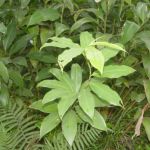| Common Name: |
Crepe Ginger |
| Botanical Name: |
Costus speciosus |
| Genus: |
Costus |
| Family: |
Zingiberaceae |
| Native Location: |
SE Asia |
| Cultivation: |
Moist, well-drained, rich, neutral to acid soil in shade and high humidity. |
| Propagation: |
Sow seed as soon as ripe at 20°C (68°F) |
| Harvest: |
Leaves, young stems and rhizomes are collected as required and used fresh, often in the form of juice. Rhizomes may also be cooked or dried. |
| Height: |
2-3m (6-10ft) |
| Width: |
1m (3ft) |
| Hardiness: |
Min. 13°C (55°F) |
| Parts Used: |
Leaves, young stems, rhizomes. |
| Properties: |
A bitter, astringent, stimulant herb that clear toxins, improves digestion, and reputedly has aphrodisiac effects. Fresh juice of rhizomes is purgative. |
| Medicinal Uses: |
Internally for eye and ear infections, diarrhea (sap from leaves, young stems), colds, mucus, coughs, dyspepsia, intestinal worms, and skin diseases (rhizomes). Formerly used in Malaysia for smallpox. |
| Bibliography: |
The Encylopedia of Herbs by Deni Brown Copyright © 1995, 2001. Dorling Kindersley Limited. pp 181-182 |

